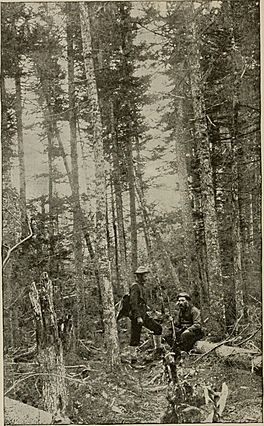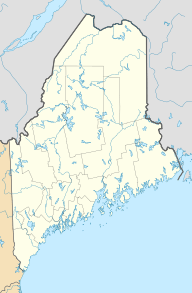Parmachenee Lake facts for kids
Quick facts for kids Parmachenee Lake |
|
|---|---|

Gilded age sportsmen carrying gear to Parmachenee Lake in the early days of the Parmachenee Club.
|
|
| Location | Oxford County, Maine |
| Coordinates | 45°09′N 70°59′W / 45.150°N 70.983°W |
| Primary inflows | Magalloway River |
| Primary outflows | Magalloway River |
| Basin countries | United States |
| Max. length | 2.9 mi (4.7 km) |
| Surface area | 913 acres (369 ha) |
| Max. depth | 93 feet (28 m) |
| Water volume | 29,130 acre⋅ft (35,930,000 m3) |
| Surface elevation | 1,629 ft (497 m) |
Parmachenee Lake is a beautiful lake located in western Maine, close to the Canadian border. It is part of the Magalloway River system. The lake gets its name from the daughter of a Native American chief named Metalluk. Parmachenee Lake is most famous for the Parmachenee Club, which was popular during the Gilded Age. The Gilded Age was a time in American history (roughly 1870-1900) when some people became very wealthy, and there was a lot of new industry.
The Magalloway River flows into the northern part of Parmachenee Lake. The lake then stretches south and overflows into the Magalloway River again, about 2 miles (3 km) upstream from the Aziscohos Reservoir.
Contents
Fishing at Parmachenee Lake
Parmachenee Lake is home to many fish, including native brook trout and land-locked Atlantic salmon. These bigger fish eat smaller ones like rainbow smelt, minnows, and suckers.
A long time ago, trout and salmon started disappearing from rivers in more crowded parts of the United States. Because of this, a group of wealthy New York lawyers decided to protect the Parmachenee Lake area. They wanted to keep it special for fishing and sport hunting for their friends and families. This group formed the Parmachenee Club.
The Parmachenee Club helped protect the lake's environment. They stopped people from hunting animals just to sell them (called market hunting) and from fishing for profit (commercial fishing). Later, the Maine Department of Inland Fisheries and Wildlife took over managing the fish populations across the whole state. The water in Parmachenee Lake is still very clean, and the native fish continue to live and reproduce there without needing to be restocked.
The Parmachenee Club's History
The Parmachenee Club was started in 1890. The club leased a huge area of forest land, about 120,000 acres, which stretched south from the Canadian border. They built a camp in the open fields along the Magalloway River. Club members would stay at this camp when they came for sport hunting and fishing trips.
Sometimes, the fields and the camp would flood. This happened because of a special dam built by the Brown Mills Company and International Paper Company. This dam was used for "log driving," which means floating cut trees down the river.
Camp Caribou
The main camp was called Camp Caribou. It was first built as a floating camp by a man named John Danforth in 1870. He later moved it to Treat's Island. In 1890, the Parmachenee Club bought Camp Caribou. They made it much bigger, adding a farm house, a farm on the east shore, and even a fish hatchery.
Eventually, Camp Caribou grew to include a main lodge, separate buildings for maids and guides, a large woodshed, and 13 individual cabins for families. The club also developed a natural spring on a hillside and piped its fresh water all the way across the lake to the camp.
A Famous Retreat
As good fishing spots became harder to find in other places, the Parmachenee Club's private area became very famous. This was before rules like fishing licenses, fishing seasons, and limits on how many fish you could catch were common. Writers who loved the outdoors often wrote about how special and untouched the club's reserve felt.
Parmachenee Lake became a popular vacation spot for some of the most important and wealthy people in the United States. One of the last famous visitors was President Dwight D. Eisenhower, who stayed in Cabin 5 in 1955. The club eventually closed down in the 1960s. The Brown Company later bought the property and used it for company meetings and trips. Today, the Island is leased to a private person and is used seasonally.
The Parmachenee Belle Fly
During the Gilded Age, fly fishing was a very popular way to catch fish. Many anglers (people who fish) would even tie their own artificial flies. Henry Parkhurst Wells, a lawyer from Rhode Island who was also a member of the Parmachenee Club, invented a special artificial fly. He named it the Parmachenee Belle to remember his fishing trips on Parmachenee Lake. This fly pattern became very popular and is still used by anglers all over the United States.



